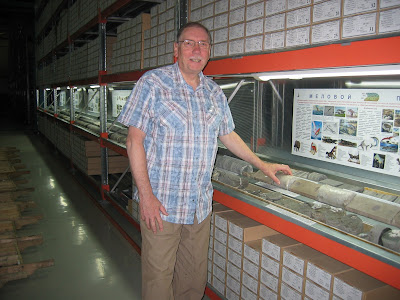Ouest-France du mardi 29 juillet 2008
Edition : Quimper - Rubriques : Quimper Ville
Débat franco-écossais sur la décentralisation
L'Écosse peut-elle être un modèle de décentralisation pour la France ? Jean-Jacques Urvoas en a débattu avec le député écossais Rob Gibson.
La décentralisation française face à la « dévolution » écossaise. Rob Gibson, député du parti nationaliste écossais (centre gauche) et Jean-Jacques Urvoas, député socialiste de Quimper, ont confronté ces deux processus, lundi à la librairie Ar Bed Keltiek. La rencontre était organisée par l'association Bretagne-Ecosse, qui encourage les échanges culturels et commerciaux entre les deux régions. L'occasion de comparer les pouvoirs respectifs des régions françaises et de l'Écosse, alors que les socialistes bretons prônent une « république des territoires ».
En septembre 1997, les Écossais disaient oui à la dévolution, un stade plus aboutit que la décentralisation à la française. « Il y avait un consensus, se souvient Rob Gibson. La volonté commune d'aller vers une démocratie sociale. » L'Écosse dispose à présent de son propre parlement, ce qui la rend plus indépendante vis-à-vis de la Grande Bretagne.
« Dans un monde globalisé, il était nécessaire d'avoir le pouvoir plus près de nous », affirme le député écossais. « Des domaines comme les énergies renouvelables ne peuvent pas être gérés par un pouvoir central qui ne connaît pas la situation locale. »
« Y a-t-il des domaines dans lesquels vous voudriez plus de compétences ? » demande Jean-Jacques Urvoas. « Les taxes, répond son homologue. Si l'Écosse percevait ne serait-ce que 10 % des taxes récoltées grâce à son pétrole, nos perspectives de développement économique s'élargiraient. »
Membre du « Breis », un groupe de socialistes bretons favorables à plus de décentralisation, le député de Quimper se montre attentif et intéressé. Ce qu'il souhaite ? « Une différence de traitement entre les régions. Nous voudrions transférer des compétences propres à chaque territoire, selon ses besoins. » Sur ce plan, la Grande-Bretagne a une longueur d'avance. « Selon leur volonté, l'Écosse et le Pays de Galles n'ont pas reçu les mêmes prérogatives de la part de l'État central », remarque l'élu écossais.
Dans un tel patchwork, se pose alors le problème identitaire. « Comment définiriez-vous la Grande-Bretagne ? » Rob Gibson évoque « une somme de nations. » « C'est une entité qui a du mal à se définir elle-même, contrairement à la France », ajoute Pierre Delignière, président de Bretagne-Ecosse.
La décentralisation française face à la « dévolution » écossaise. Rob Gibson, député du parti nationaliste écossais (centre gauche) et Jean-Jacques Urvoas, député socialiste de Quimper, ont confronté ces deux processus, lundi à la librairie Ar Bed Keltiek. La rencontre était organisée par l'association Bretagne-Ecosse, qui encourage les échanges culturels et commerciaux entre les deux régions. L'occasion de comparer les pouvoirs respectifs des régions françaises et de l'Écosse, alors que les socialistes bretons prônent une « république des territoires ».
En septembre 1997, les Écossais disaient oui à la dévolution, un stade plus aboutit que la décentralisation à la française. « Il y avait un consensus, se souvient Rob Gibson. La volonté commune d'aller vers une démocratie sociale. » L'Écosse dispose à présent de son propre parlement, ce qui la rend plus indépendante vis-à-vis de la Grande Bretagne.
« Dans un monde globalisé, il était nécessaire d'avoir le pouvoir plus près de nous », affirme le député écossais. « Des domaines comme les énergies renouvelables ne peuvent pas être gérés par un pouvoir central qui ne connaît pas la situation locale. »
« Y a-t-il des domaines dans lesquels vous voudriez plus de compétences ? » demande Jean-Jacques Urvoas. « Les taxes, répond son homologue. Si l'Écosse percevait ne serait-ce que 10 % des taxes récoltées grâce à son pétrole, nos perspectives de développement économique s'élargiraient. »
Membre du « Breis », un groupe de socialistes bretons favorables à plus de décentralisation, le député de Quimper se montre attentif et intéressé. Ce qu'il souhaite ? « Une différence de traitement entre les régions. Nous voudrions transférer des compétences propres à chaque territoire, selon ses besoins. » Sur ce plan, la Grande-Bretagne a une longueur d'avance. « Selon leur volonté, l'Écosse et le Pays de Galles n'ont pas reçu les mêmes prérogatives de la part de l'État central », remarque l'élu écossais.
Dans un tel patchwork, se pose alors le problème identitaire. « Comment définiriez-vous la Grande-Bretagne ? » Rob Gibson évoque « une somme de nations. » « C'est une entité qui a du mal à se définir elle-même, contrairement à la France », ajoute Pierre Delignière, président de Bretagne-Ecosse.
Antoine LANNUZEL.


 Rob Gibson, député du SNP (parti nationaliste de centre gauche)
Rob Gibson, député du SNP (parti nationaliste de centre gauche)










